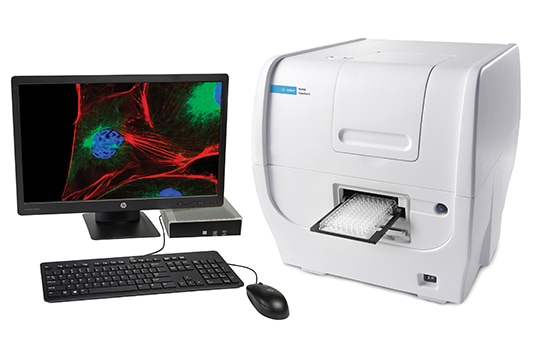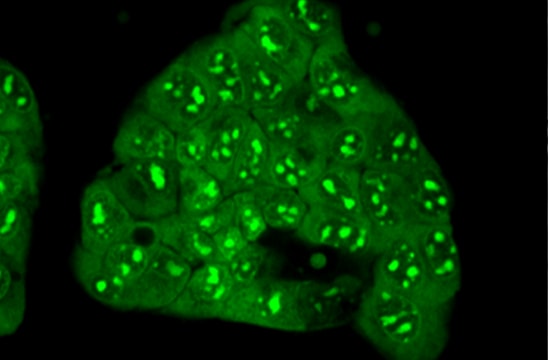Reactive Oxygen Species and Antioxidant Activity
September 2022
Reactive Oxygen Species (ROS) is a term used to describe a number of highly reactive molecules and free radicals derived from molecular oxygen. These molecules present an interesting dichotomy to mammalian cells given that they are continuously exposed to ROS during their lifespan—depending on them for a number of normal cellular processes, whilst being vulnerable to their potentially damaging effects. Small amounts of ROS can act as important signal transduction molecules, with recent work demonstrating their role in apoptosis, gene expression, and the activation of cell signaling cascades1. However, these molecules, produced as byproducts during the mitochondrial electron transport of aerobic respiration or by oxidoreductase enzymes and metal catalyzed oxidation, have the potential to cause a number of deleterious events due to their reactivity. Under normal circumstances, excess ROS can be scavenged by antioxidant defense mechanisms, including enzymatic systems and non-enzymatic low molecular weight compounds acting together to detoxify ROS conditions and prevent cell damage. As examples, the cellular enzyme superoxide dismutase (SOD) catalyzes the dismutation of superoxide into oxygen, and hydrogen peroxide and catalase enzyme catalyzes the breakdown of hydrogen peroxide to water and oxygen. The thiol glutathione, which exists primarily in its reduced state, serves as a cellular antioxidant by reacting with ROS molecules before they can cause cellular damage. Oxidized glutathione is then converted back to the reduced state by the action of glutathione reductase.
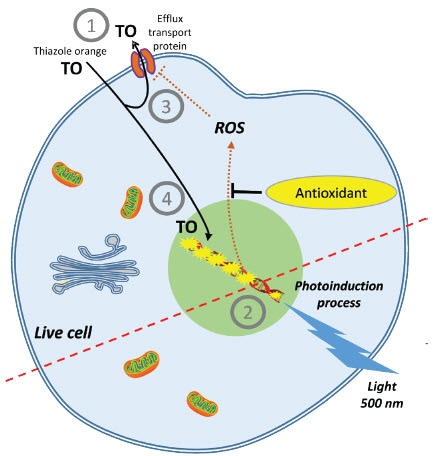
Figure 1. AOP1 assay. Effect is measured as the ability of antioxidants to quench ROS production, keeping TO out of the cell and resulting in low fluorescence.
External antioxidant sources are relied upon as an additional mechanism to assist in the reduction or removal of excess ROS in a living system. Plants have been identified as a countless source of antioxidant extracts/compounds, and both academia and industry have intensively explored this diversity for decades, looking for the antioxidant grail. Numerous in vitro chemical assays such as DPPH, FRAP, and ORAC among others, have been developed for the purpose of measuring the antioxidant activity of phytochemicals in an acellular environment. However, these approaches provide limited insight into the antioxidant effect in living organisms. In contrast, dichlorofluorescin diacetate (DCFH-DA) was used as a fluorescence marker in the first cell-based assay that directly evaluates the cellular antioxidant activity (CAA) of a substance inside the cell quantitatively. More recently the use of high intensity light to activate an intracellular photosensitizer (thiazole orange) has allowed the measurement of antioxidant activity in live cells with considerably less cell leakage than DCFH-DA. Furthermore, the photoinduction process called Light-Up Cell System (LUCS) results in the production of ROS moieties in the thiazole orange dye that alters efflux and allow rapid entry of more thiazole orange. Employing this system, antioxidant activity is measured by the ability of test compounds to suppress ROS-induced increase in LUCS fluorescence. This technology can be used to assess compound antioxidant activity concurrent with markers for cell viability.
In this TekTalk we’ve compiled diverse ROS-related resources, including an overview of biological processes involving ROS and relevant detection strategies, emerging assay formats for characterizing ROS activity in live cells, as well as tips for optimizing you ROS assays.
Featured Applications
An Introduction to Reactive Oxygen Species
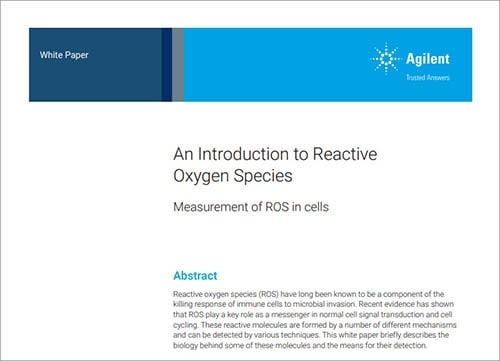
Reactive oxygen species (ROS) have long been known to be a component of the killing response of immune cells to microbial invasion. Recent evidence has shown that ROS play a key role as a messenger in normal cell signal transduction and cell cycling. These reactive molecules are formed by a number of different mechanisms and can be detected by various techniques. This white paper briefly describes the biology behind some of these molecules and the means for their detection.
Quantitative Assessment of Antioxidant Activities in Living Cells
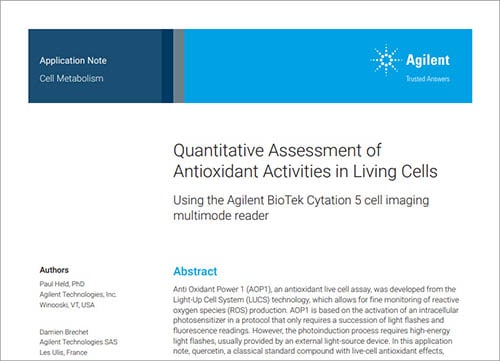
Anti Oxidant Power 1 (AOP1), an antioxidant live cell assay, was developed from the Light-Up Cell System (LUCS) technology, which allows for fine monitoring of reactive oxygen species (ROS) production.
AOP1 is based on the activation of an intracellular photosensitizer in a protocol that only requires a succession of light flashes and fluorescence readings.
Product Spotlight
Agilent BioTek Cytation 5 Cell Imaging Multimode Reader
BioTek Cytation 5 is a modular, upgradable multimode reader that combines automated digital microscopy and conventional microplate detection. Cytation 5 includes filter- and monochromator-based detection; the microscopy module provides up to 60x magnification in fluorescence, brightfield, color brightfield and phase contrast. Incubation to 65 °C, shaking and Gen5 software are standard.
Watch this video to learn more about the complete Cytation line of cell imaging multimode readers.
Tek Tips
Choice of cell line
The choice of cell is an important element in the study of ROS and cellular oxidative stress. The cell type needs to be aligned with the experimental questions. For example, endothelial cells from lung tissue will have a markedly different capacity than cells from liver tissue to accommodate oxidative stress. Lung cells are exposed to a much higher oxygen tension than liver cells and as such have developed a greater capacity to mitigate deleterious ROS compounds. Superoxide dismutase and catalase are expressed at high levels in these cells. Cancer cells are often more sensitive to enhanced intracellular ROS than normal cells.
Choice of media
Many of the reagents used to assess ROS levels in cells are fluorescent based. Normal tissue culture media typically has phenol red as a pH indicator as well as numerous flavonoid compounds that are often fluorescent. Rhodamine and ethidium-based sensor dyes may have excitation and emission wavelengths that overlap that of phenol red. Likewise, flavonoid compounds fluoresce at similar wavelengths to fluorescein derived sensors. To reduce these issues there are numerous media formulations that do not contain phenol red. Medias labeled as Imaging media often have formulations that are lower in flavonoids and lack phenol red resulting in much lower background fluorescence as compared to normal media formulations
Dye loading
Many of the reagents used to assess cellular ROS are membrane permanent esters and are typically inactive. When they pass through cell membrane, they are hydrolyzed intracellularly to an ionic compound that is retained in the cell. It is necessary to preload these dyes for 30 minutes in order for their conversion to take place. Once loading has been accomplished unincorporated dye is removed by replacing the media with fresh. It is advisable to work as expeditiously as possible, as leakage of the active indicator dye from cells can occur. Many cell types have organic ion transport systems, such as the P-glycoprotein multidrug-transporter, which are capable of actively eliminating the indicator dye from the cell.
Webinars
LUCS: An Innovative Cell-based Assay Technology
Presenter: Jean Marc Josse, PhD, Founder, Biohexis Conseil, Beta d'Orion
Wednesday, October 12, 2022, 12 PM EDT
AOP (Anti Oxidant Power) is proud to introduce the LUCS technology, a simple, efficient, cost- effective and powerful new protocol/kits to address the analysis of in cell anti- oxidant cell effects and cell cytotoxicity with multiplexing of analysis in the same assay. LUCS technology is simple to automate and has been tested with a large number of instruments.
The LUCS system is compatible with all eukaryotic and prokaryotic cell lines, making it the only universal ROS monitoring technology suitable for routine high throughput applications.
This webinar includes:
- An introduction to the biochemistry behind LUCS
- A presentation of applications and results demonstrating the power and benefits of the technology
1 Hancock, J.T., R. Desikan, S.J. Neill, (2001) Role of Reactive Oxygen Species in Cell Signaling Pathways. Biochemical and Biomedical Aspects of Oxidative Modification, 29(2):345-350.
